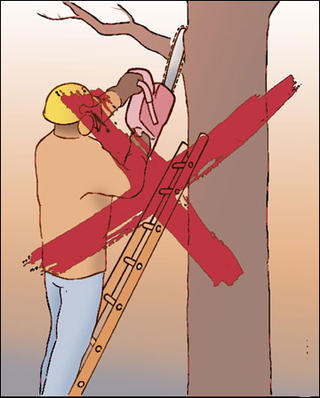Trees, Saws and Ladders Don't Mix!
 In May of 2011, a Lexington, Kentucky, woman was struck by a falling tree limb and died. According to a local news report, the woman was holding a ladder for her husband, who was standing on it to trim a tree branch caught in a power line. The large limb fell, spinning her around and knocking her face-first into the concrete. The county coroner ruled the death accidental, listing the cause of death as blunt force trauma to the head.
In May of 2011, a Lexington, Kentucky, woman was struck by a falling tree limb and died. According to a local news report, the woman was holding a ladder for her husband, who was standing on it to trim a tree branch caught in a power line. The large limb fell, spinning her around and knocking her face-first into the concrete. The county coroner ruled the death accidental, listing the cause of death as blunt force trauma to the head.
“This tragic story is, unfortunately, not an isolated incident,” says Tchukki Andersen, Board Certified Master Arborist, Certified Tree Safety Professional and staff arborist for the Tree Care Industry Association. “There are many stories in the news media each year depicting the sad details of homeowners getting severely injured or killed by attempting to manage large tree limbs on their own.”
“Tree work, while appearing fairly straightforward and simple, is actually extremely complicated and technical,” Andersen adds. “There is so much to understand about removing live or hanging tree branches, and it is not at all like cutting up firewood on the ground with a chain saw.”
Qualified tree professionals are trained to look for and take special precaution against:
- Trees or branches with decay, cracks or unbalanced weight
- Working near overhead electrical wires and other conductors
- Preventing falls from trees they are working on
- Removing portions of or entire trees without causing bodily harm or property damage
Do-it-yourself homeowners have been hurt trying to cut their own trees in the following manners:
Extension Ladders
Oops! If your ladder is too short to reach the branch, do not make the mistake of setting it on something unsteady to get the reach you need. Get a sturdy ladder that will reach at least 5 feet beyond the branch you lean it on. When a large branch is cut from a tree, the loss of the weight will cause the rest of the limb to suddenly lurch up. Many unaware homeowners have been severely injured, some fatally, when the ladder they are standing on falls out from under the branch they are cutting. The biggest danger is taking too big or too unwieldy of a piece at one time. Cut the limb in small pieces.
Improper Tools
Oops! Are you going to borrow your brother-in-law’s chain saw? When was the last time that tool was properly sharpened or maintained? A dull chain forces you to use too much pressure, causing you to lose control. This can lead to many problems, most of them leading to the hospital for emergency treatment of deep lacerations to your body. Andersen notes, “Use properly maintained equipment and the right size saw for the job.”
Lack of knowledge about tree physics and biology
Oops! It can’t be done with just one cut. This is where those lacking experience in cutting live limbs from trees get hurt almost every time. Trees are mechanically complex organisms that need to be cut in a certain way to remove pieces of them safely. Cutting off a large section of limb to save time will usually cause the branch to fall before the cut is finished. The cut end will often tear into the branch all the way back to the trunk. This action can cause damage to the tree (and to you) as it swings out of control, usually onto the ladder you are standing on – or the person holding the ladder. Therefore, it is always recommended to remove a large limb in sections.
Find a professional
If you are at all uncertain about what could happen by attempting your own tree work, contact a qualified tree care professional. A professional arborist can determine the best way to accomplish the task at hand, and has the experience and proper equipment to do the job. They just may prevent an injury, or even save a life!
Not sure where to look? Click here to search for a TCIA Member company in your area .
Photo Credit: University of Missouri Extension School of Natural Resources